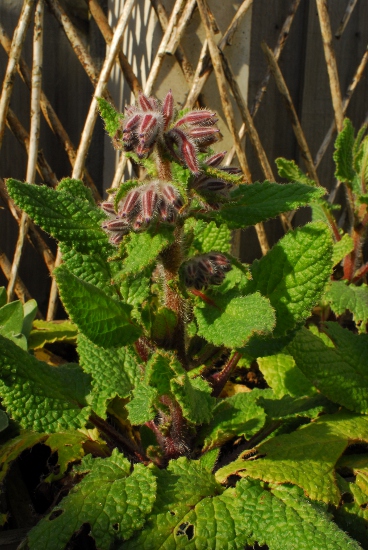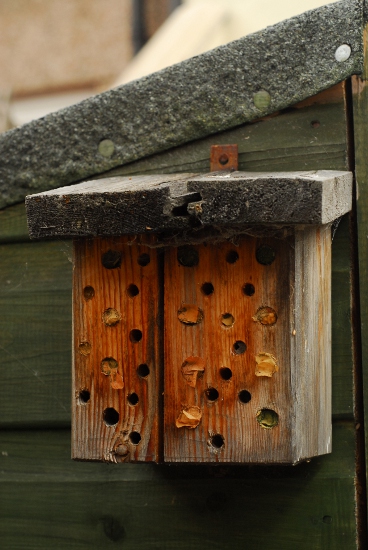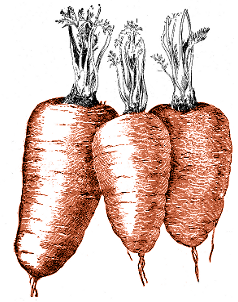Posts tagged ‘borage’
Posted in Experimentation, Garden Diary, Practicalities, The Old Garden In Bristol on Thursday, April 14th 2016 (9.46 PM).
The first few pea shoots started to break the surface a couple of days ago, making it five days after sowing. Rather fast, I thought; only a few have come up so far, which makes me worry I’ve kept them too damp or something.
In the meantime I’ve been clearing out the back bed, into which the peas are going to be transplanted once large enough. A few years ago, I spent weeks clearing bindweed out of it, going through the soil archaeologically to excavate the tiniest pieces of bindweed rhizome. Now, after a couple of years of baby-rearing abandonment, it’s been colonised by rosebay willowherb. So I’m going through the soil almost archaeologically again, pulling out chunky pieces of rosebay willowherb rhizome this time. Hopefully I have got as much as possible: if I’ve missed any, once there are other plants in there the archaeological approach isn’t likely to work very well. I will have to resort to pulling up each shoot again and again until the rhizomes are exhausted.
There is still no signs of the calendula seeds we sowed twelve days ago germinating. To be honest I have no idea how long they normally take to germinate, but as I usually tend towards the impatient side, and I was always a bit skeptical that the packet would still contain viable seeds, I am suspecting that nothing is going to appear. Pushing on ahead, today we planted a pot of borage seeds (Borage officinalis) and another of poached eggs, which is hardly the nicest plant name I’ve ever come across, so I think I’ll just refer to it as Limnanthes douglasii from now on. Both pots will only really be large enough for one plant of each; a rather small plant in the borage’s case; but that will suffice. There may be just enough room for one borage plant in the back bed too, in front of the peas, but I doubt it with everything else I’d like to squeeze in there.
We did also buy a few plants from the greenhouse at St Werburghs City Farm, which sells plants as part of its horticulture training scheme for adults with special needs. A couple of chervil (Anthriscus cerefolium) and a dwarf variety of sunflower, which hopefully should grow to about the same height as the children. They were repotted this afternoon, despite a cold shower of rain, and with the children “helping” moving the compost about.
borage, calendula, chervil, germination, limnanthes douglasii, pea, rosebay willowherb, sowing, sunflower, weeding
Posted in Garden Diary, The Old Garden In Bristol on Sunday, March 23rd 2014 (9.16 PM).
It hasn’t been a cold winter, but it feels like it’s been a long, wet winter, a winter for slugs and snails. Moreover, the last time I wrote something on this blog, we had zero children in the family. Today, we have two children in the family; things have been a little busy in the past few months.
Spring has sprung, though, and the summer flowers I mentioned previously are starting to bloom. The borage plants have sprung up thick, hairy stems, looking ridiculously large in the box they are growing out of, hanging clusters of buds starting to open. Here’s a picture from a couple of weeks ago, just before they did:

One calendula plant has blossomed; the rest have fat buds nestling in their hearts. One box of the forget-me-nots is a green carpet with one or two small, gemlike lilac flowers starting to appear.
Strangely, though, not all of the flowers are doing as well as the others. We planted five boxes, in a line on top of the garden wall, borage in the middle, calendula either side, forget-me-nots at either end. The two boxes on the shadier side of the borage are doing very well; on the other side, the calendula has a couple of slightly sick-looking plants in it, and the forget-me-not box has a couple of small seedlings, hardly anything compared to the thick growth at the other end of the wall. If anything, I would have thought things would have gone the opposite way around, and the sunnier boxes would be those doing best.
The white clover we planted as a green manure had also flowered, beautiful tiny white flowers. It was probably supposed to be dug in before that happened; never mind. Today, I turned it all over, and also tried to get up the taproots of a couple of dandelions that had settled in there over the winter. No doubt I didn’t quite manage to dig all over the clover up; I’m not really bothered if I didn’t. If we ever have a garden large enough for a lawn, I’d much rather fill the space with camomile, clover, and other similar low-growing plants. Next week, after the clover has started to rot down, I will try to make sure I sow something else.
borage, calendula, clover, forget-me-not, white clover
Posted in Environmentalism, Garden Diary, The Old Garden In Bristol on Saturday, September 14th 2013 (10.32 PM).
There is one benefit, of course, to leaving the garden to go to seed for a year. It means that the wildlife can get along with things all on their own, without me coming along to pull up their homes and generally keep disturbing things. Whilst clearing the garden up in the past few weeks, we’ve seen lots of shieldbugs, crab spiders, caterpillars, various different insects and suchlike going about their own business and making the most of the place.
A couple of years ago, we bought a bee house, and nailed it up on the wall of the shed. It saw little use, to be honest, apart from by spiders and a couple of holes filled by a mason bee last year. This summer, though, leafcutter bees have found it, and made good use of it.

As you can see from the picture, leafcutter bees are quite picky about the sizes of the holes they will lay eggs in. You can also see one of the holes which a mason bee presumably crawled out of earlier in the year. Hopefully, at some point in the spring, a family of newly-mature leafcutter bees will emerge again.
In other news, we have sowed a few flowers ready for next summer: calendula, forget-me-not and borage. Slowly we’re drifting away from the original idea of making the garden as edible as we could, but that was never a strictly hard-and-fast rule to start with. They are, at least, all flowers which should please the leafcutters and bumblebees at various times next spring and summer. On the herb front, we’ve acquired a few stems of bay, and planted them in one of the wastebins used in previous seasons for growing potatoes. Growing potatoes is difficult to justify in a garden the size of ours; hopefully the bay will make a bush to last for a few years to come.
bay, bee, bee house, borage, calendula, forget-me-not, leafcutter



